He was a man of infinite kindness and understanding, deeply devoted to the school, and was distinguished not only for his high principles of character but for his integrity and sense of justice.
Reverend John Vansittart Buckland, the son of J R Buckland, was 24 at the time of his father’s death, and had spent most of his life at Hutchins. Born in Hobart on and enrolled at Hutchins in , he completed his Associate of Arts degree in , following which he obtained a post as Assistant Classical Master at the Melbourne Church of England Grammar School. Buckland returned to Tasmania with the intention of adopting the legal profession and was articled to the Hobart firm of his old schoolmates, Butler, McIntyre and Butler. The ensuing vacancy at the helm of Hutchins was enough to make him change his mind and take over the management of the School, which was by now heavily associated with his name.
By Buckland was Acting Headmaster. Canon Archer was appointed Acting Headmaster while Buckland studied for Holy Orders and an Arts degree from Melbourne University. Following his ordination in , Buckland became Headmaster in his own right. The growth of the School during Buckland’s term saw alterations and improvements to classrooms and grounds, and the addition of new buildings and play areas: the fives court in , a carpenter’s shop and playing shed (the ‘Marble Shed’) in and a ‘fairly-equipped’ gymnasium, an ‘asphalt lawn’ tennis court in , and ‘a brick schoolroom 40 ft by 20 ft’ (the ‘New Room’) in .
Evidence of Buckland’s attention to detail and respect for the historical record has survived in his handwritten lists of enrolments and scholastic attainments achieved during his term and notes on the proposed affiliation of Hutchins with Christ’s College in , as well as his personal scrapbook and his annotated list accompanying the photographs he requested from former pupils.
Buckland successfully continued the shift in emphasis begun by his father — from a classical education to a more modern, technical and practical one — by adding carpentry, chemistry and other branches of natural science to the curriculum and allowing sporting activities like gymnastics and athletics to flourish. Modern European languages offered from included Italian, and German as a substitute for Greek. Buckland employed a female art teacher, Miss Elizabeth Blyth, and perhaps the most enduring monument to his term was the founding in of the Hutchins Cadet Corps, usually ascribed to his brother, William Buckland, also a teacher at Hutchins.
The death of Buckland’s mother in , the Matron of the School, was an event that became the catalyst for major change at Hutchins. After 18 years in charge, Buckland left the School in and departed for England, where he took charge of various parishes until his death on . It was the end of an era, comprising nearly 50 years of proprietary management by members of the Buckland family. Buckland left the School in a ‘flourishing position’ with 130 pupils and a stable staff team.
John Buckland was… one of the foundations on which we relied, and when he left those who had been some six years or more under him felt that something had passed out of their lives — one of the accepted facts of our existence, which nothing could replace. The success of the school was due to the magnificent team work of the Buckland family. One realised it only after one had left school.

